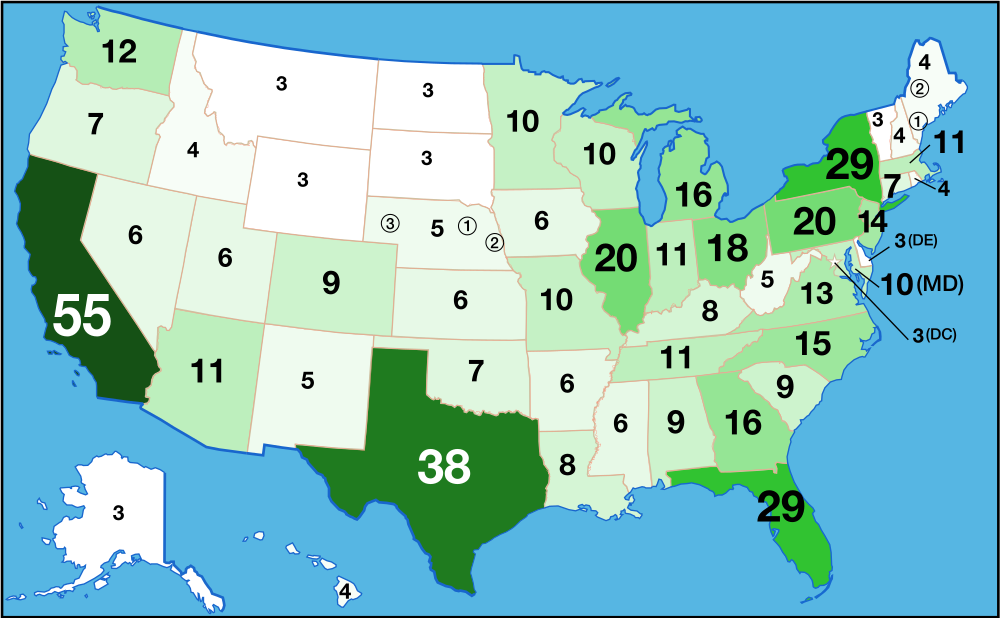
Map of Electoral College; caption: The number of Electoral College votes in each U.S. state. (UserTwoSix, CC BY 4.0 <https://creativecommons.org/licenses/by/4.0>, via Wikimedia Commons)
I’ll bet you thought you voted for the presidential and vice-presidential candidates of your choice. You didn’t. You voted for a slate of electors chosen by that candidate’s party, who on December 14 will vote for the candidate. The outcome of our presidential elections is not dictated by the popular vote. How did this state of affairs come to be?
The Constitutional Convention of 1787 was a contentious event. Originally intending to reform the Articles of Confederation, its members instead devised an entirely new framework for government. They divided government into three branches, each with different duties and powers. These branches—legislative (the bicameral congress), executive (the president), and judicial (the judiciary, including the Supreme Court)—were supposed to exercise a system of checks and balances on one another.
The selection of a president was especially problematic. No one wanted a king, but the Founders were highly suspicious of raw direct democracy, which they viewed as akin to mob rule. More than any other single topic, this one engendered the most debate—over twenty-one days and thirty votes—before a compromise was reached in the final days of the Convention. At 346 words, the process for selecting the president is the longest single part of the Constitution. The president would be selected by state-based electors, allegedly the most informed men (white, property-owning men) in each state. This was no brilliant plan. Exhausted after a hot, steamy summer in Philadelphia, the Founders hastily cobbled together what has been called the “Frankenstein Compromise” so they could go home.
Each state was allocated a number of electoral votes equal to its number of House representatives plus two (for its senators). Because of the clause counting a slave as three-fifths of a citizen, the slaveholding states had extra power* in selecting the president. James Madison and Alexander Hamilton envisioned the electors as free agents, not pledged to any candidate, representing a congressional district and casting their votes in the state by district. The immediate rise of political parties and the decision in 1789 by Pennsylvania and Maryland to award electoral votes on a winner-take-all basis doomed such idealism. Originally the electors cast votes only for president, with the runner-up becoming vice president. The elections of 1796 and 1800 showed the folly of that approach, leading to the Twelfth Amendment, which required electors to cast separate ballots for president and vice president. The defects were thus immediately apparent, and the power imparted to the Southern states by the Electoral College materially contributed to the Civil War.
Over the ensuing years there have been more than 700 attempts to reform the Electoral College. Senator Birch Bayh of Indiana led an effort to abolish the Electoral College in the 1960s; one of the backers of this effort was the League of Women Voters. The amendment to abolish the Electoral College and elect the president by popular vote seemed poised to pass in 1970 and go to the states for ratification, but it died in the Senate Judiciary Committee as a result of opposition from three Southern segregationist Senators: James Eastland (D-Mississippi), Strom Thurmond (R-South Carolina), and Sam Ervin (D-North Carolina). Why? Despite the Supreme Court decision in Gray v. Sanders in 1963, which affirmed the “one person, one vote” principle of democracy, Eastland and the other segregationist senators preferred to maintain white Southern political power. The presidential election would not be “one person, one vote.”
The United States is left with an eighteenth-century tradeoff in the twenty-first century. As a result, the past twenty years have seen presidential elections in which two of the five candidates lost the popular vote but won the Electoral College to become president. In fact, until the Electoral College is abolished (by constitutional amendment) or neutered (by the National Popular Vote Interstate Compact, NPVIC), that threat will continue to haunt American democracy. The NPVIC would require member states to cast their electoral votes for the winner of the national popular vote. The League of Women Voters supports the NPVIC. Jesse Wegman’s excellent book on this subject, Let the People Pick the President: The Case for Abolishing the Electoral College, will make the reason for this support clear. I encourage all to read it.
—Thad Zajdowicz, Co-chair, Healthcare Committee
Editor’s notes: According to the Congressional Research Service time line for the 2020 presidential election and Electoral College vote, the U.S. Code (3 U.S.C. §5) “provides that if election results are contested in any state, and if the state, prior to election day, has enacted procedures to settle controversies or contests over electors and electoral votes, and if these procedures have been applied, and the results have been determined six days before the electors’ meetings, then these results are considered to be conclusive, and will apply in the counting of the electoral votes.” This date is known as the “Safe Harbor” deadline.
Electors are then scheduled by law to vote in their states on the second Wednesday in December, which in 2020 is December 14. In another deadline set by law, members of Congress will meet in a joint session of both houses on January 6, 2021, to count the Electoral College votes and declare the election results. As of this writing, a bill has been introduced in the Senate that proposes to change the Safe Harbor date and other Electoral College deadlines to later dates for the 2020–21 election. The bill has not yet been voted on by the Senate.
*Regarding the extra power accorded to whites in slaveholding states by means of the Electoral College, a cogent explanation of this oppressive effect—fully understood and acknowledged by the Founders—is provided by Wilfred Codrington III in his article “The Electoral College’s Racist Origins” (The Atlantic, November 17, 2019).